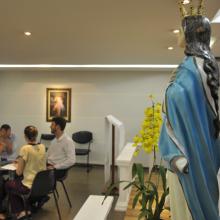mediation
IN 1974, TWO teenagers went on a vandalism spree in the quiet community of Elmira, Ontario. They slashed car tires, broke store windows, and destroyed a garden gazebo, racking up about $3,000 worth of damage. The pair faced jail time for malicious vandalism. Instead, their parole officer, Mark Yanzi, who was also part of Mennonite Central Committee in Canada, asked the presiding judge if the youths could meet their victims face to face. This, they said, would allow the offenders to apologize directly and pay for damages. The judge agreed—setting legal precedent in Canada.
Though Indigenous and First Nations communities have a long history of similar conflict resolution practices, the Elmira case is seen as a moment when formalized restorative justice models, known at the time as victim-offender reconciliation programs (VORP), entered the Canadian criminal legal system. And Mennonite Christians were integral from the beginning.
In a 1989 handbook, VORP Organizing: A foundation in the church, Ron Claassen, Howard Zehr, and Duane Ruth-Heffelbower further developed the concept of VORP as a program that could work in cooperation with the judicial system but embodied “different assumptions about crime and punishment.”
“True justice requires that things be made right between the one offended and the one who has done the offending. It embodies a concept of restoration—of victim as well as offender. This also implies personal accountability on the part of the offender, who is encouraged to acknowledge his or her responsibility for the harm, participate in deciding what needs to be done, and to take steps to make amends,” they wrote.

Image via Goias Courts of Justice / RNS
A pioneering mediation program in Brazil is banking on religious leaders using their conciliatory skills to resolve conflicts between families and neighbors, while helping the judicial system reduce a massive backlog of cases overloading the country’s courts. The “Mediar e Divino” (“To Mediate is Divine”) pilot project in the state of Goias, has started training evangelical pastors, Catholic priests, and Protestant ministers on the legalities of reconciling bickering parties and settling social squabbles.
POLICE BRUTALITY, the Affordable Care Act, climate change: When people with differing convictions on issues such as these come together for conversation, some prefer to first set aside the issues and focus on building relationships, while others want disagreements front and center. In his book I Beg to Differ: Navigating Difficult Conversations With Truth and Love, Biola University communications professor Tim Muehlhoff says relationship and honesty are necessary for progress to be made.
“If every conversation we have with others is about the issues that divide us, the intensity will hurt the communication climate,” he writes.
For example, he offers the hypothetical story of an evangelical Christian who wants to share his faith with a Muslim co-worker. Over lunch, the colleagues take time to learn about each other’s differing religious convictions, but the conversation doesn’t invade their work relationship. Back at the office, they return to their easygoing, day-to-day relational habits.
It’s a mistake to begin conversations by trying to convince others of our position, Muehlhoff says. It is better to listen with a sincere desire to understand what the other person believes and why they believe it.
Bio: Tyrone Parker is the executive director of Alliance of Concerned Men (ACM), a nonprofit that works with youth living in high-crime areas in Washington, D.C.
1. What event or episode in your life has most informed your passion for working with urban youth and families?
One was the loss of my son, Rodney [who was killed in 1989]. The other was the record number of homicides within the District of Columbia. The District was once considered the “murder capital” of the United States.
When we first got started with the intervention program, it was due to a 12-year-old kid who was shot in the nation’s capital on the day of the Clinton inauguration. If you would’ve gone 10 minutes on East Capitol Street, you would’ve seen the inauguration with a major celebration. And 10 minutes down the same street, you had a whole community under house arrest. After that, we came together as a group to form the Alliance of Concerned Men.
2. What sorts of services and programs does ACM provide?
We teach a number of skills to at-risk youth, including gang intervention/prevention and mediation, workforce development, life skills training, leadership development, coaching for re-entry, and youth gang conflict resolution.
EACH DAY REV. JAMES BYENSI seeks the face of God in one of the world’s deadliest places, an environment where rape has been used as a weapon, children have had their innocence stolen, and the church of Jesus Christ is called to stand in the gap.
He lives in Bunia, a town on the eastern edge of the Democratic Republic of Congo (DRC). And while only the largest events of the DRC’s conflict—such as the M23 militia’s takeover of Goma, a city 300 miles south of Bunia—make world headlines, every day Byensi engages his community and country as an active agent of peace. For example, recently he helped deter a cycle of violence from escalating in his hometown. “Even as I write, I have just received a call from the mayor to join him in talking to a group of people who are protesting against the killing of their brother last night,” Byensi told Sojourners in October in one of several email interviews. “The killers were one of the rebel groups operating in the area surrounding Bunia.” While advocacy against violence is a cause close to Byensi’s heart, the protest itself threatened to become part of the problem: “Protest in this area is always violent and followed by looting or even rape,” he explained. The result of that meeting was that Byensi and the mayor together “devised the way to address the people and cool them down,” which included the mayor’s office helping the bereaved citizens with burial expenses.
That is the kind of advocacy and justice work Byensi does on a daily basis as a leadership and conflict-management consultant and trainer, and through the nonprofit he founded, the Rebuilders Ministry.
I've been navel gazing again and wondering how we come to know ourselves. I wonder what that right balance is between our inner-barometer of self-knowing and that external one that people reflect back to us. "Ubuntu," (I am because of who we are) or all the various "I am..." statements: "I think therefore I am" (Descartes) or "I am what I am and that's all that I am" (Popeye)...What statements might we add to this list? Bishop Desmond Tutu expands the notion of Ubuntu thusly:
One of the sayings in our country is Ubuntu – the essence of being human. Ubuntu speaks particularly about the fact that you can't exist as a human being in isolation. It speaks about our interconnectedness. You can't be human all by yourself, and when you have this quality – Ubuntu – you are known for your generosity. We think of ourselves far too frequently as just individuals, separated from one another, whereas you are connected and what you do affects the whole World. When you do well, it spreads out; it is for the whole of humanity.
I'm trying to wrap my mind about how we construct the self. Judith Butler, Catherine Bell (ritualization) and others inhabit my mind lately. Ritual, tradition, story, identity... the list goes on and on ...



